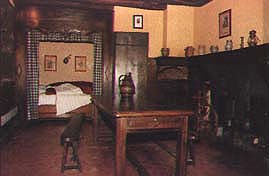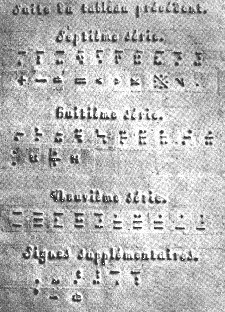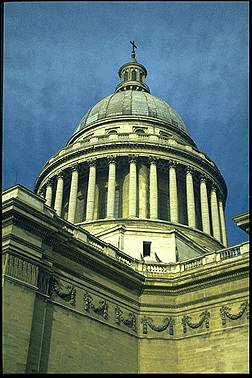 . . . .. .
. . . .. . 
|
|
|
One day a small boy crept into his father's workshop to play. He had often seen his father making shoes and he decided he would like to try. He picked up an awl, a sharp, pointed tool used for making holes in leather. As he bent over, the awl slipped and pierced his eye, destroying it forever. Some time later his other eye became infected by the first and he lost his sight altogether.
So how did this child, blinded at the age of 4, become one of the most famous Frenchmen ever to live?
 . . . .. .
. . . .. . 
Louis Braille was born in a small town near Paris in 1809. Despite his impaired vision the young child attended the village school with his sighted friends for two years. Eventually it became clear that he would not be able to learn much more, largely because he could not read or write. Without an education it was likely that he would have to beg on the streets, like other blind people in those days.
At the age of ten he was lucky enough to be sent to a school for blind boys in Paris, one of the first in the world. Conditions in the school were very harsh. The building was damp and unhealthy and discipline was severe. Pupils who misbehaved were beaten, locked up and given stale bread and water. In fact this kind of discipline was common in all schools at that time. Life was harsh for nearly everyone and most sighted children left school at the age of 12 and went to work in factories or down mines.
At the school in Paris the blind pupils were taught practical skills like chair caning and slipper making so that when they left the school they would be able to make a living. Once a week, after lunch, the boys were taken for a walk in the park, linked together by a long rope.
They were also taught to read but not to write. The letters they read were raised above the surface of the page so that they could feel them with their fingertips. This form of writing was very difficult to read because it was very hard to tell the letters apart. The letters were printed by pressing copper wire into one side of the paper to make a raised shape on the other. Because each individual letter had to be made out of wire first and because the wire then had to be forced into the paper with a press blind people were unable to write anything for themselves.
Inventing the Braille alphabet
One day something happened that changed their lives forever. In 1821 a soldier named Charles Barbier came to visit the school. He bought with him a system he had invented called 'night writing'. 'Night writing' had originally been designed so that soldiers could pass instructions along trenches at night without having to talk and give their positions away. It consisted of twelve raised dots which could be combined to represent different sounds. Unfortunately it proved to be too difficult for soldiers to master and was therefore rejected by the army.
The young Louis Braille quickly realised how useful this system of raised dots could be, provided it was simplified. Over the next few months he experimented with different systems until he found an ideal one using six dots. He continued to work on the scheme for several years after, developing separate codes for maths and music. In 1827 the first book in braille was published.

Even so the new system did not catch on immediately. Sighted people did not understand how useful braille could be and one head teacher at the school even banned the children from learning it. Fortunately this seemed to have the effect of encouraging the children even more and they took to learning it in secret. Eventually even sighted people began to realise the benefits of the new system.
Not only could people with impaired vision read braille but they could also write it for themselves using a simple stylus to make the dots. For the first time they began to be truly independent and to take control of their own lives.
What happened to Louis when he grew up?
Louis Braille eventually became a teacher in the school where he had been a student. He was admired and respected by his pupils but, unfortunately, he did not live to see his system widely adopted. He had always been plagued by ill health and in 1852, at the age of 43, he died from tuberculosis. For a while it seemed as if his system would die with him.

Fortunately a few key people had realised the importance of his invention. In 1868 a group of four blind men, led by Dr Thomas Armitage, founded the British and Foreign Society for Improving the Embossed Literature of the Blind. This small band of friends grew and grew to become the Royal National Institute for the Blind, the largest publisher of braille in Europe and Britain's largest organisation for people with impaired vision.
By 1990 braille was being used in almost every country in the world and had been adapted to almost every known language, from Albanian to Zulu.
In France itself, Louis Braille's achievement was finally recognised by the state. In 1952 his body was moved to Paris where it was buried in the Pantheon, the home of France's national heroes.

.